Practice Free 300-410 Exam Online Questions
Refer to Exhibit:
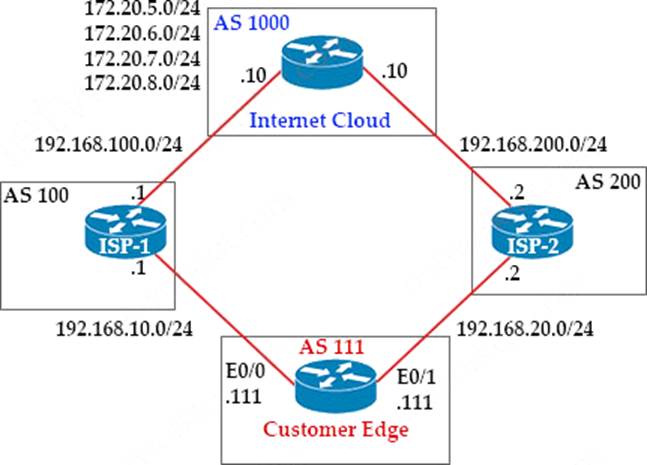
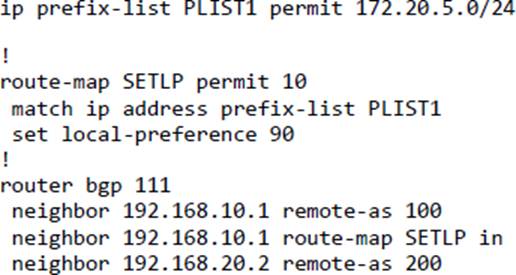
AS 111 wanted to use AS 200 as the preferred path for 172.20.5.0/24 and AS 100 as the backup. After the configuration, AS 100 is not used for any other routes.
Which configuration resolves the issue?
- A . route-mmap SETLP permit 10
match ip address prefix-list PLIST1
set local-preference 99
route-map SETLP permit 20 - B . route-map SETLP permit 10
match ip address prefix-list PLIST1
set local-preference 110
route-map SETLP permit 20 - C . router bgp 111
no neighbor 192.168.10.1 route-map SETLP in
neighbor 192.168.10.1 route-map SETLP out - D . router bap 111
no neighbor 192.168.10.1 route-map SETLP in
neighbor 192.168.20.2 route-map SE TLP in
A
Explanation:
There is an implicit deny all at the end of any route-map so all other traffic that does not match 172.20.5.0/24 would be dropped. Therefore we have to add a permit sequence at the end of the route-map to allow other traffic.
The default value of Local Preference is 100 and higher value is preferred so we have to set the local preference of AS100 lower than that of AS200.
Refer to the exhibit.
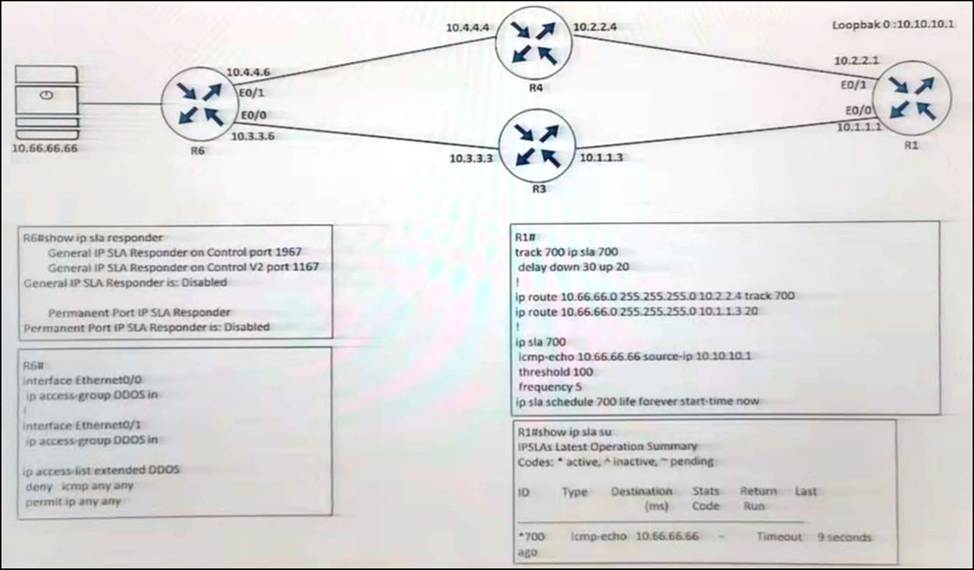
R1 is configured with IP SLA to check the availability of the server behind R6 but it kept failing.
Which configuration resolves the issue?
- A . R6(config)# ip sla responder
- B . R6(config)# ip sla responder udp-echo ip address 10.10.10.1 port 5000
- C . R6(config)# ip access-list extended DDOS
R6(config ext-nac)# 5 permit icmp host 10.66 66.66 host 10.10.10.1 - D . R6(config)# ip access-list extended DDOS
R6(confg ext-nac)# 5 permit icmp host 10.10.10.1 host 10.66.66.66
D
Explanation:
In this IP SLA tracking, we don’t need a IP SLA Responder so the command “ip sla responder” on R6 is not necessary.
We also notice that the ACL is blocking ICMP packets on both interfaces E0/0 & E0/1 of R6 so we need to allow ICMP from source 10.10.10.1 to destination 10.66.66.66.
The network administrator configured R1 to authenticate Telnet connections based on Cisco ISE using TACACS+. ISE has been configured with an IP address of 192.168.1.5 and with a network device pointing toward R1(192.168.1.1) with a shared secret password of Cisco123.
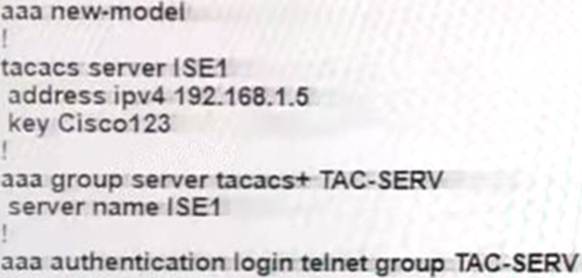
The administrator cannot authenticate to R1 based on ISE.
Which configuration fixes the issue?
- A . ip tacacs-server host 192.168.1.5 key Cisco123
- B . line vty 0 4login authentication TAC-SERV
- C . line vty 0 4login authentication telnet
- D . tacacs-server host 192.168.1.5 key Cisco123
C
Explanation:
The last command “aaa authentication login telnet group TAC-SERV” created the method list name telnet so we need to assign it to line vty.
Reference: https://www.cisco.com/c/en/us/support/docs/security/identity-services-engine/200208-Configure-ISE-2-0-IOS-TACACS-Authentic.html
A company is expanding business by opening 35 branches over the Internet. A network engineer must configure DMVPN at the branch routers to connect with the hub router and allow NHRP to add spoke routers securely to the multicast NHRP mappings automatically.
Which configuration meets this requirement at the hub router?
- A . interface Tunnel0
ip address 10.0.0.1 255.255.255.0
ip nhrp authentication KEY1
ip nhrp nhs dynamic
ip nhrp network-id 10
tunnel mode mgre auto - B . interface Tunne10
ip address 10.0.0.1 255.255.255.0
ip nhrp authentication KEY1
ip nhrp registration no-unique
ip nhrp network-id 10
tunnel mode gre nmba - C . interface Tunnel0
ip address 10.0.0.1 255.255.255.0
ip nhrp authentication KEY1
ip nhrp map multicast dynamic
ip nhrp network-id 10
tunnel mode gre multi pointe - D . interface Tunnel0
ip address 10.0.0.1 255.255.255.0
ip nhrp authentication KEY 1
ip nhrp map multicast 224.0.0.0
ip nhrp network-id 10
tunnel mode gre ipv4
C
Explanation:
The command “ip nhrp map multicast dynamic” allows NHRP to automatically add spoke routers to the multicast NHRP mappings.
Refer to Exhibit.
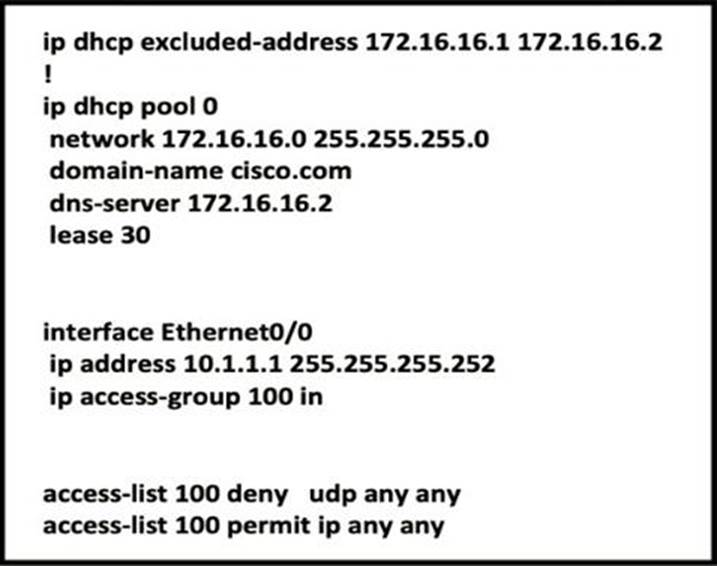
Which two configurations allow clients to get dynamic ip addresses assigned?
- A . Configure access-list 100 permit udp any any eq 61 as the first line
- B . Configure access-list 100 permit udp any any eq 86 as the first line
- C . Configure access-list 100 permit udp any any eq 68 as the first line
- D . Configure access-list 100 permit udp any any eq 69 as the first line
- E . Configure access-list 100 permit udp any any eq 67 as the first line
C,E
Explanation:
A DHCP server that receives a DHCPDISCOVER message may respond with a DHCPOFFER message on UDP port 68 (BootP client).
…
In the event that the DHCP server is not on the local subnet, the DHCP server will send the DHCPOFFER, as a unicast packet, on UDP port 67, back to the DHCP/BootPRelay Agent from which the DHCPDISCOVER came.
Reference: https://www.cisco.com/c/en/us/support/docs/ip/dynamic-address-allocation-resolution/27470-100.html
Users were moved from the local DHCP server to the remote corporate DHCP server. After the move, none of the users were able to use the network.
Which two issues will prevent this setup from working properly? (Choose two)
- A . Auto-QoS is blocking DHCP traffic.
- B . The DHCP server IP address configuration is missing locally
- C . 802.1X is blocking DHCP traffic
- D . The broadcast domain is too large for proper DHCP propagation
- E . The route to the new DHCP server is missing
Refer to the exhibit.
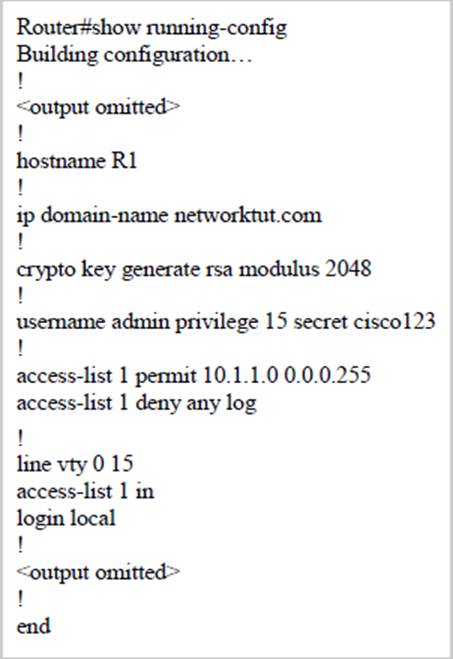
A user cannot SSH to the router.
What action must be taken to resolve this issue?
- A . Configure transport input ssh
- B . Configure transport output ssh
- C . Configure ip ssh version 2
- D . Configure ip ssh source-interface loopback0
A
Explanation:
https://www.cisco.com/c/en/us/td/docs/switches/lan/catalyst2960x/software/15-0_2_EX/security/configuration_guide/b_sec_152ex_2960-x_cg/b_sec_152ex_2960-x_cg_chapter_01001.html
Refer to the exhibit.

R3 is dual-homed to two service providers for traffic redundancy. R3 prefers its outbound traffic via R2.
Which set of configurations achieves this goal?
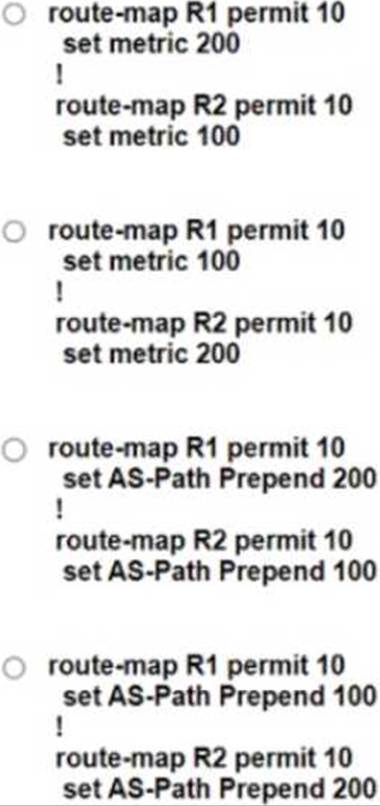
- A . Option A
- B . Option B
- C . Option C
- D . Option D
Refer to the exhibit.
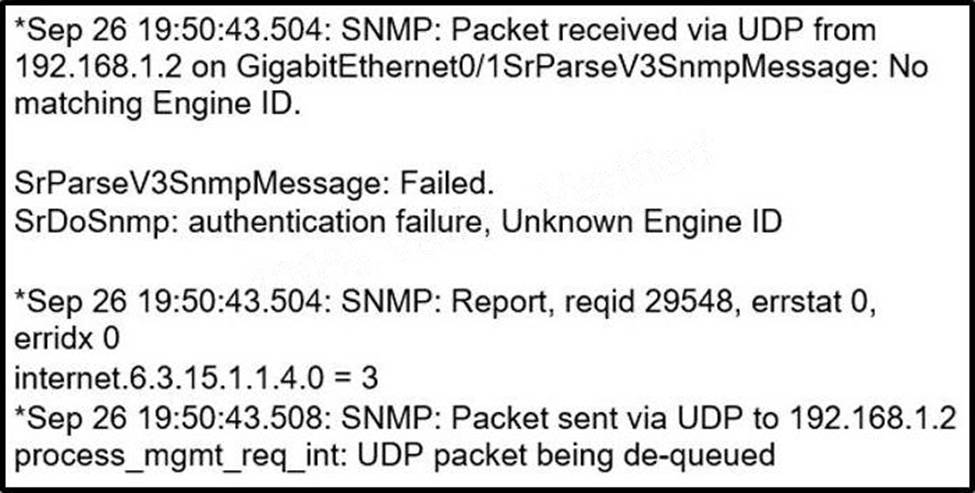
Which two commands provide the administrator with the information needed to resolve the issue? (Choose two.)
- A . snmp user
- B . debug snmp engine-id
- C . debug snmpv3 engine-id
- D . debug snmp packet
- E . showsnmpv3 user
Refer to the exhibit.

An engineer configures the router 10.1.100.10 for EIGRP auto summarization so that R1 should receive the summary route of 10.0.0.0/8. However, R1 receives more specific /24 routes.
Which action resolves this issue?
- A . Router R1 should configure ip summary address eigrp (AS number) 10.0.0.0 255.0.0.0 for the R1 Fast Ethernet 0/0 connected interface.
- B . Router R1 should configure ip route 10.0.0.0 255.0.0.0 null 0 for the routes that are received on R1.
- C . Router 10.1.100.10 should configure ip route 10.0.0.0 255.0.0.0 null 0 for the routes that are summarized toward R1.
- D . Router 10.1.100.10 should configure ip summary address eigrp (AS number) 10.0.0.0 255.0.0.0 for the R1 Fast Ethernet 0/0 connected interface.
